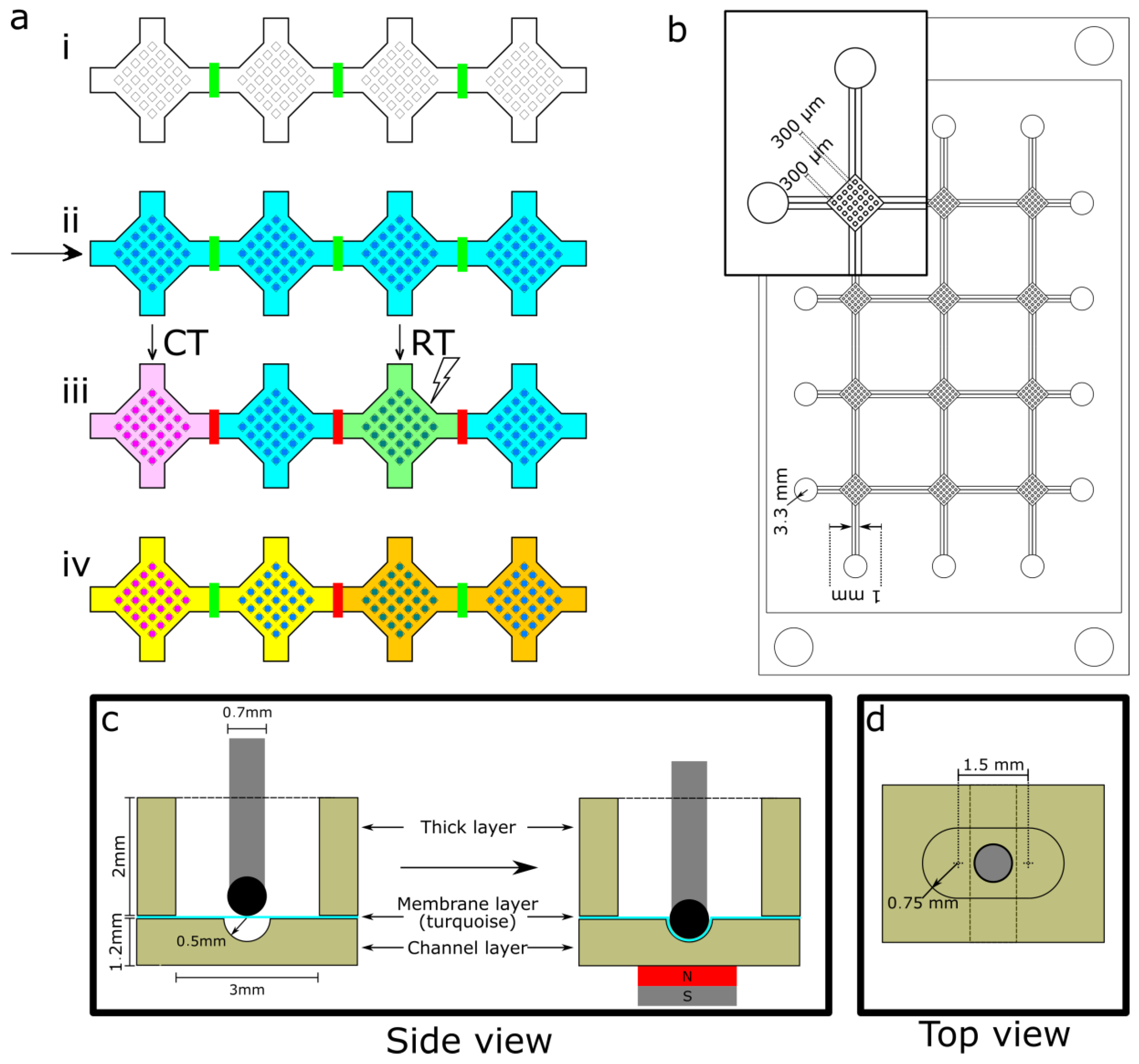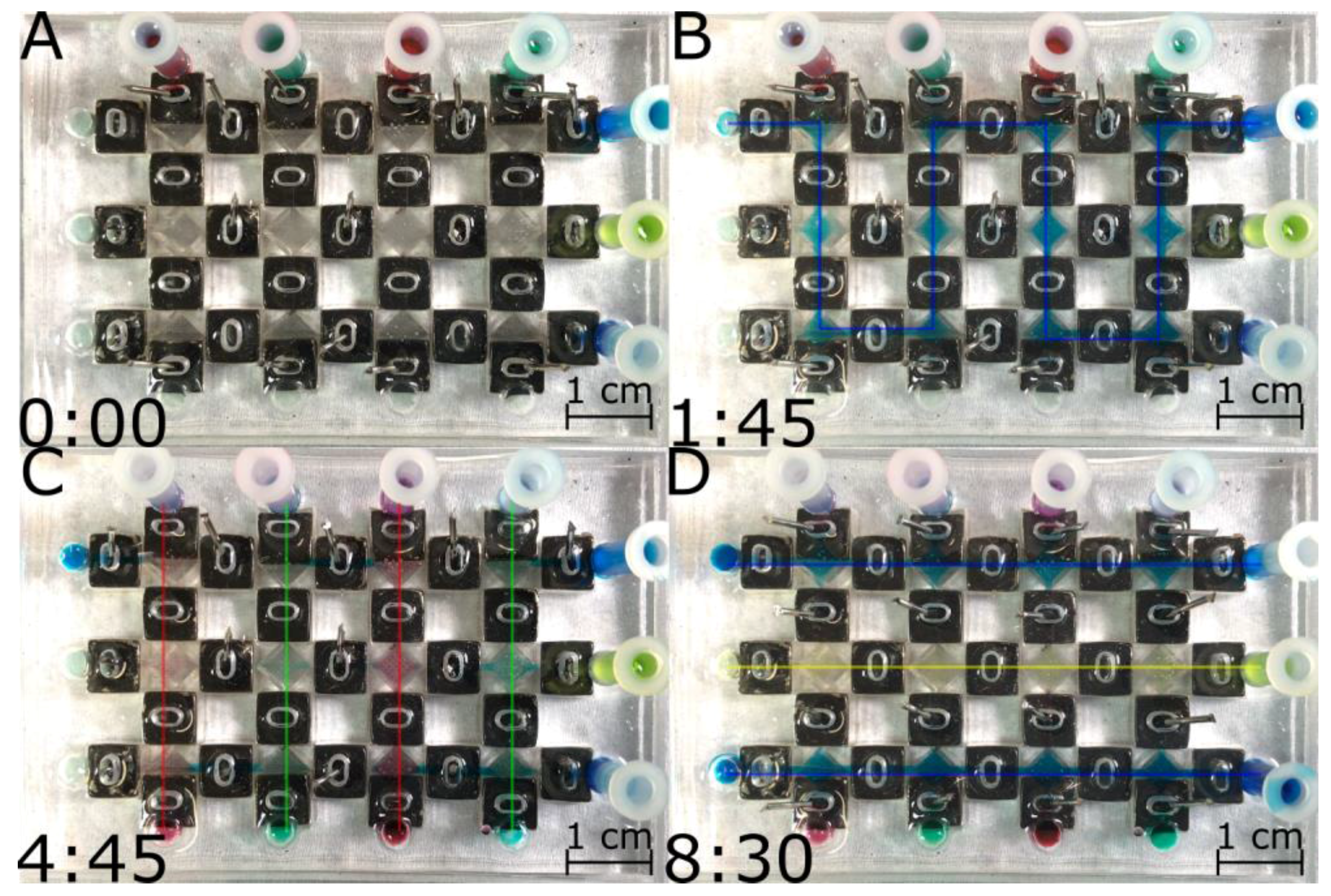Reconfigurable Microfluidic Magnetic Valve Arrays: Towards a Radiotherapy-Compatible Spheroid Culture Platform for the Combinatorial Screening of Cancer Therapies
Abstract
1. Introduction
2. Materials and Methods
2.1. Description of the Design
2.1.1. Valve Design
2.1.2. Spheroid Culture Chamber Arrays (SCCA)
2.2. Fabrication and Assembly
2.2.1. Molds and Substrates
2.2.2. Device Molding and Assembly
2.2.3. Device Assembly
2.2.4. Valves Reusable Parts
2.3. Experimental Procedure
2.3.1. Experimental Protocol for Valve Resistance
2.3.2. Experimental Protocol for SCCA
3. Results and Discussion
3.1. Valve Resistance
3.1.1. Pressure Resistance
3.1.2. Diffusion Resistance
3.2. Fluid Routing Using Valve Arrays in the SCCA
4. Discussion and Conclusions
Supplementary Materials
Acknowledgments
Author Contributions
Conflicts of Interest
References
- Mosquera, C.; Maglic, D.; Zervos, E.E. Molecular targeted therapy for pancreatic adenocarcinoma: A review of completed and ongoing late phase clinical trials. Cancer Genet. 2016, 209, 567–581. [Google Scholar] [CrossRef] [PubMed]
- Reardon, D.A.; Gilbert, M.R.; Wick, W.; Liau, L. Immunotherapy for neuro-oncology: The critical rationale for combinatorial therapy. Neuro Oncol. 2015, 17, vii32–vii40. [Google Scholar] [CrossRef] [PubMed]
- Stupp, R.; Mason, W.P.; Van Den Bent, M.J.; Weller, M.; Fisher, B.; Taphoorn, M.J.B.; Belanger, K.; Brandes, A.A.; Marosi, C.; Bogdahn, U.; et al. Radiotherapy plus Concomitant and Adjuvant Temozolomide for Glioblastoma. N. Engl. J. Med. 2005, 35210, 987–996. [Google Scholar] [CrossRef] [PubMed]
- Bonner, J.A.; Harari, P.M.; Giralt, J.; Azarnia, N.; Shin, D.M.; Cohen, R.B.; Jones, C.U.; Sur, R.; Raben, D.; Jassem, J.; et al. Radiotherapy plus Cetuximab for Squamous-Cell Carcinoma of the Head and Neck. N. Engl. J. Med. 2006, 354, 567–578. [Google Scholar] [CrossRef] [PubMed]
- Wong, P.; Houghton, P.; Kirsch, D.G.; Finkelstein, S.E.; Monjazeb, A.M.; Xu-Welliver, M.; Dicker, A.P.; Ahmed, M.; Vikram, B.; Teicher, B.A.; et al. Combining targeted agents with modern radiotherapy in soft tissue sarcomas. J. Natl. Cancer Inst. 2014, 106, 16–18. [Google Scholar] [CrossRef] [PubMed]
- Hutchison, S.; Rae, C.; Tesson, M.; Babich, J.W.; Boyd, M.; Mairs, R.J. Evaluation of Melanin-Targeted Radiotherapy in Combination with Radiosensitizing Drugs for the Treatment of Melanoma. Cancer Oncol. Res. 2014, 2, 58–67. [Google Scholar] [CrossRef]
- Falkenberg, N.; Höfig, I.; Rosemann, M.; Szumielewski, J.; Richter, S.; Schorpp, K.; Hadian, K.; Aubele, M.; Atkinson, M.J.; Anastasov, N. Three-dimensional microtissues essentially contribute to preclinical validations of therapeutic targets in breast cancer. Cancer Med. 2016, 5, 703–710. [Google Scholar] [CrossRef] [PubMed]
- Morgan, M.M.; Johnson, B.P.; Livingston, M.K.; Schuler, L.A.; Alarid, E.T.; Sung, K.E.; Beebe, D.J. Personalized in vitro cancer models to predict therapeutic response: Challenges and a framework for improvement. Pharmacol. Ther. 2016, 165, 79–92. [Google Scholar] [CrossRef] [PubMed]
- Kadletz, L.; Heiduschka, G.; Domayer, J.; Schmid, R.; Enzenhofer, E.; Thurnher, D. Evaluation of spheroid head and neck squamous cell carcinoma cell models in comparison to monolayer cultures. Oncol. Lett. 2015, 1281–1286. [Google Scholar] [CrossRef] [PubMed]
- Weiswald, L.-B.; Bellet, D.; Dangles-Marie, V. Spherical Cancer Models in Tumor Biology. Neoplasia 2015, 17, 1–15. [Google Scholar] [CrossRef] [PubMed]
- Choi, J.; Lee, E.K.; Choo, J.; Yuh, J.; Hong, J.W. Micro 3D cell culture systems for cellular behavior studies: Culture matrices, devices, substrates, and in-situ sensing methods. Biotechnol. J. 2015, 10, 1682–1688. [Google Scholar] [CrossRef] [PubMed]
- Achilli, T.-M.; Meyer, J.; Morgan, J.R. Advances in the formation, use and understanding of multi-cellular spheroids. Expert Opin. Biol. Ther. 2012, 12, 1347–1360. [Google Scholar] [CrossRef] [PubMed]
- McMillan, K.S.; McCluskey, A.G.; Sorensen, A.; Boyd, M.; Zagnoni, M. Emulsion technologies for multicellular tumour spheroid radiation assays. Analyst 2016, 141, 100–110. [Google Scholar] [CrossRef] [PubMed]
- Rousset, N.; Monet, F.; Gervais, T. Simulation-assisted design of microfluidic sample traps for optimal trapping and culture of non-adherent single cells, tissues, and spheroids. Sci. Rep. 2017, 7, 245. [Google Scholar] [CrossRef] [PubMed]
- Thorsen, T.; Maerkl, S.J.; Quake, S.R. Microfluidic large-scale integration. Science 2002, 298, 580–584. [Google Scholar] [CrossRef] [PubMed]
- Park, E.S.; Brown, A.C.; DiFeo, M.A.; Barker, T.H.; Lu, H. Continuously perfused, non-cross-contaminating microfluidic chamber array for studying cellular responses to orthogonal combinations of matrix and soluble signals. Lab Chip 2010, 10, 571–580. [Google Scholar] [CrossRef] [PubMed]
- Unger, M.A.; Chou, H.-P.; Thorsen, T.; Scherer, A.; Quake, S.R. Monolithic Microfabricated Valves and Pumps by Multilayer Soft Lithography. Science 2000, 288, 113–116. [Google Scholar] [CrossRef] [PubMed]
- Folch, A. Introduction to BioMEMS; CRC Press: Boca Raton, FL, USA, 2012; pp. 145–167. [Google Scholar]
- Li, A.; Khosla, A.; Drewbrook, C.; Gray, B.L. Fabrication and testing of thermally responsive hydrogel-based actuators using polymer heater elements for flexible microvalves. In Proceedings of the SPIE, San Francisco, CA, USA, 22–27 January 2011; Volume 7929. [Google Scholar]
- Jackson, W.C.; Tran, H.D.; O’Brien, M.J.; Rabinovich, E.; Lopez, G.P. Rapid prototyping of active microfluidic components based on magnetically modified elastomeric materials. J. Vac. Sci. Technol. B Microelectron. Nanom. Struct. 2001, 19, 596. [Google Scholar] [CrossRef]
- Pamme, N. Magnetism and microfluidics. Lab Chip 2006, 6, 24–38. [Google Scholar] [CrossRef] [PubMed]
- Beebe, D.J.; Moore, J.S.; Bauer, J.M.; Yu, Q.; Liu, R.H.; Devadoss, C.; Jo, B.-H. Functional hydrogel structures for autonomous flow control inside microfluidic channels. Nature 2000, 404, 588–590. [Google Scholar] [CrossRef] [PubMed]
- Rahbar, M.; Seyfollahi, S.; Khosla, A.; Gray, B.L.; Shannon, L. Fabrication Process for Electromagnetic Actuators Compatible with Polymer Based Microfluidic Devices. ECS Trans. 2012, 41, 7–17. [Google Scholar] [CrossRef]
- Pirmoradi, F.; Cheng, L.; Chiao, M. A magnetic poly(dimethylesiloxane) composite membrane incorporated with uniformly dispersed, coated iron oxide nanoparticles. J. Micromech. Microeng. 2010, 20, 15032–15037. [Google Scholar] [CrossRef]
- Gaspar, A.; Piyasena, M.E.; Daroczi, L.; Gomez, F.A. Magnetically controlled flexible valve for flow manipulation in polymer microfluidic devices. Microfluid. Nanofluid. 2008, 4, 525–531. [Google Scholar] [CrossRef]
- Comina, G.; Suska, A.; Filippini, D. PDMS lab-on-a-chip fabrication using 3D printed templates. Lab Chip 2014, 14, 424–430. [Google Scholar] [CrossRef] [PubMed]
- Yamanishi, Y.; Lin, Y.-C.; Arai, F. Magnetically modified PDMS microtools for micro particle manipulation. In Proceedings of the 2007 IEEE/RSJ International Conference on Intelligent Robots and Systems, San Diego, CA, USA, 29 October–2 November 2007; pp. 753–758. [Google Scholar]
- Ouellet, V.; Zietarska, M.; Portelance, L.; Lafontaine, J.; Madore, J.; Puiffe, M.-L.; Arcand, S.L.; Shen, Z.; Hébert, J.; Tonin, P.N.; et al. Characterization of three new serous epithelial ovarian cancer cell lines. BMC Cancer 2008, 8, 152. [Google Scholar] [CrossRef] [PubMed]
- Lounis, H.; Mes-Masson, A.M.; Dion, F.; Bradley, W.E.; Seymour, R.J.; Provencher, D.; Tonin, P.N. Mapping of chromosome 3p deletions in human epithelial ovarian tumors. Oncogene 1998, 17, 2359–2365. [Google Scholar] [CrossRef] [PubMed]
- Briganti, E.; Kayal, T.A.; Kull, S.; Losi, P.; Spiller, D.; Tonlorenzi, S.; Berti, D.; Soldani, G. The effect of gamma irradiation on physical-mechanical properties and cytotoxicity of polyurethane-polydimethylsiloxane microfibrillar vascular grafts. J. Mater. Sci. Mater. Med. 2010. [Google Scholar] [CrossRef] [PubMed]
- Palsule, A.S.; Clarson, S.J.; Widenhouse, C.W. Gamma Irradiation of Silicones. J. Inorg. Organomet. Polym. Mater. 2008, 18, 207–221. [Google Scholar] [CrossRef]
- Baker, J.T. Fluorescein Bar 100G M422-05. Available online: http://www.labplanet.com/jt-baker-fluorescein-bar-100g-m422-05.html (accessed on 11 July 2017).





| Day 0 | Assembly of the device Air bubbles removal through manual filling with 70% ethanol and isopropanol Injection of pluronic solution (10 mg/mL) Incubation for 24 h at room temperature |
| Day 1 | Flush with water to remove excess pluronic Fill with cell medium (DMEM/F12) RT treatment of 0 to 8 Gy (8 Gy considered default) |
| Day 1–X | Incubation at 37 °C for 0 to 6 days (6 days considered default) |
© 2017 by the authors. Licensee MDPI, Basel, Switzerland. This article is an open access article distributed under the terms and conditions of the Creative Commons Attribution (CC BY) license (http://creativecommons.org/licenses/by/4.0/).
Share and Cite
Brunet, A.R.; Labelle, F.; Wong, P.; Gervais, T. Reconfigurable Microfluidic Magnetic Valve Arrays: Towards a Radiotherapy-Compatible Spheroid Culture Platform for the Combinatorial Screening of Cancer Therapies. Sensors 2017, 17, 2271. https://doi.org/10.3390/s17102271
Brunet AR, Labelle F, Wong P, Gervais T. Reconfigurable Microfluidic Magnetic Valve Arrays: Towards a Radiotherapy-Compatible Spheroid Culture Platform for the Combinatorial Screening of Cancer Therapies. Sensors. 2017; 17(10):2271. https://doi.org/10.3390/s17102271
Chicago/Turabian StyleBrunet, Alexandre R., Frédérique Labelle, Philip Wong, and Thomas Gervais. 2017. "Reconfigurable Microfluidic Magnetic Valve Arrays: Towards a Radiotherapy-Compatible Spheroid Culture Platform for the Combinatorial Screening of Cancer Therapies" Sensors 17, no. 10: 2271. https://doi.org/10.3390/s17102271
APA StyleBrunet, A. R., Labelle, F., Wong, P., & Gervais, T. (2017). Reconfigurable Microfluidic Magnetic Valve Arrays: Towards a Radiotherapy-Compatible Spheroid Culture Platform for the Combinatorial Screening of Cancer Therapies. Sensors, 17(10), 2271. https://doi.org/10.3390/s17102271






